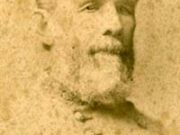W. T. Wofford was a cavalry captain in the Mexican War (1846-48), a Georgia politician, and a Confederate colonel (later brigadier general) during the Civil War (1861-65). Though originally against secession, Wofford supported his home state when Georgia seceded from the Union, and he participated in several major battles during the course of the Civil War. In his later years Wofford was elected to the U.S. House of Representatives and participated in the state constitutional convention of 1877.
Early Life
William Tatum Wofford was born on June 28, 1824, in Habersham County, to Nancy M. Tatum and William Hollingsworth Wofford. He attended local schools before enrolling at the University of Georgia in Athens. He studied law and was admitted to the bar in Athens, in Clarke County, and then set up his practice in Cassville, in Cass County (later Bartow County). During the Mexican War, Wofford captained a battalion of Georgia mounted volunteers. He returned home in 1848 and decided to enter politics, serving in the Georgia state legislature from 1849 to 1853. Wofford decided not to run for the 1853-54 session of the legislature, but he was elected by the lower house to serve as clerk for that year. During this time Wofford edited the Cassville Standard and ran his plantation in Cassville, where he enslaved ten people.
On August 1, 1859, Wofford married Julia Adelaide Dwight. They had four daughters, only one of whom, Helena D. Wofford, survived to adulthood. In 1861, as a member of the state convention, Wofford voted against seceding from the Union. However, when the Georgia order of secession was signed on January 21, 1861, Wofford volunteered for military service.
Civil War Service
Wofford began his service as colonel of the Eighteenth Georgia Infantry, which comprised volunteers from Bartow, Dooly, Dougherty, Gordon, Jackson, and Newton counties. It was organized on April 22, 1861, at Camp Brown in Cobb County. After serving in North Carolina and Virginia, the regiment was assigned to General John Bell Hood’s Texas Brigade. While with the Texas Brigade, Wofford and his men fought in Virginia at the battles of Yorktown and Second Bull Run, and in Maryland at South Mountain, Sharpsburg, and Antietam.
There is some disagreement about who commanded the brigade at the Battle of Second Bull Run. Regimental commanders were not sure to whom they should address their after-action reports, because no one knew exactly who was in charge. Reports were directed at Major W. H. Sellers (Hood’s adjutant), Hood, and Wofford. In the casualty report Wofford is listed as commander of the Texas Brigade; as the next ranking officer under Hood, it is possible that Wofford took command at one point. Following these engagements in November 1862, the Eighteenth Georgia Infantry was transferred to the Georgia Brigade under Thomas R. R. Cobb. After Cobb fell at the Battle of Fredericksburg, Wofford assumed command; on January 17, 1863, he was promoted to brigadier general.
For the next two years Wofford served with the Army of Northern Virginia. He led the Georgia brigade at Chancellorsville, Virginia, and Gettysburg, Pennsylvania, where his men fought in the assault through the Peach Orchard battlefield and defeated Union troops on the Wheatfield battlefield. They were forced to stop just before the newly formed Union line near Little Round Top. Wofford also saw action in 1864 during the Overland campaign in Virginia at the Battle of the Wilderness and in Spotsylvania. During the Battle of the Wilderness, Wofford helped plan and implement Lieutenant General
Wofford spent his leave in Murray County, at the home of his in-laws. Union troops occupied Cassville, where many homes, including his own, were burned. Enslaved people had fled, and deserters were looting the area. After Wofford recovered from his wounds at the end of 1864, he requested that the Eighteenth Georgia Brigade return to its home state. When Confederate general Robert E. Lee declined to grant his request, Georgia governor Joseph E. Brown asked that Wofford not return to his brigade but instead assume command of the Department of North Georgia. Charged with defending Georgians from rogue forces and guerrilla attacks, Wofford rounded up stragglers, deserters, and any available men in north Georgia to strengthen his forces. He held this position from January until his formal surrender to Union general James Steedman at Kingston, in Bartow County, on May 12, 1865. He was later paroled at Resaca, in Gordon County, and eventually pardoned in July 1865. Four thousand men came into Kingston to surrender. Wofford’s Confederate soldiers were the last significant troops east of the Mississippi River to surrender to the Union.
Later Years
In 1865 Wofford was elected to the U.S. House of Representatives. Republicans dominated Congress, however, and kept Wofford, along with other Georgia Democratic congressmen, from assuming his seat. Wofford focused his energy on the law, Democratic politics, and the expansion of railroads. He also sat on several education boards and donated a parcel of land in Bartow County as the site of a public school, called Wofford Academy, which functioned as a church school on weekends. In 1877 he served as a member of the state constitutional convention, where he took a stand against convict leasing and argued for Confederate veterans’ benefits and African Americans’ rights.
Soon after his wife died in 1878, Wofford married Margaret Langdon. Following a long illness, Wofford died on May 22, 1884, in Bartow County. He is buried in Cassville’s Confederate Cemetery alongside 300 unknown soldiers of the Civil War.




